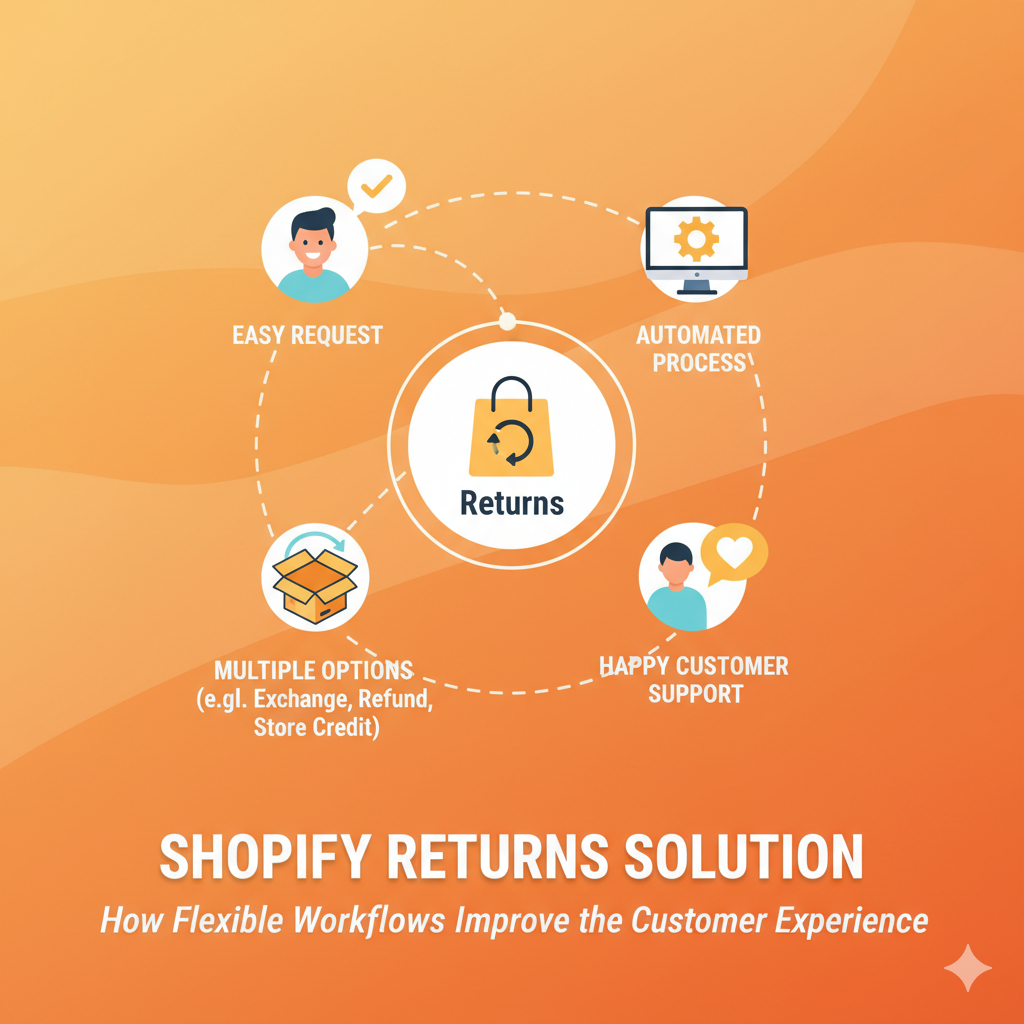If you run a Shopify store, you already know how exciting it is to see new orders come in. But there’s one part of eCommerce that no seller enjoys returns.
They’re time-consuming, messy, and if not handled right, they can easily ruin the customer experience you worked so hard to build.
That’s where Shopify’s returns management solutions and flexible workflows come in. Let’s understand what they are, how they work, and how you can use them to make your post-purchase experience smoother and more profitable.
Why Returns Management Matters in eCommerce
Returns are a part of the eCommerce reality. Whether you sell clothing, tech accessories, or home products, some percentage of your orders will come back.
In fact, industry reports suggest that 20–30% of online purchases end up being returned. And how you handle those returns says a lot about your brand.
When done right:
- It builds trust with your customers.
- Encourages repeat purchases.
- Turns negative experiences into loyal relationships.
But when done poorly:
- Customers lose confidence.
- You face higher operational costs.
- Your brand reputation takes a hit.
That’s exactly why Shopify has invested heavily in improving return solutions through custom workflows.
What Is the Shopify Returns Solution?
Shopify’s return solution is a built-in system that allows merchants to manage returns directly within their dashboard — without relying on complex third-party tools.
You can:
- Approve or deny return requests
- Issue refunds
- Track return shipments
- Create custom rules for eligibility
- Automate communication with customers
In short, it’s a centralized hub for post-purchase management, integrated with your store’s existing order and inventory system.
The Problem with Traditional Return Processes
Let’s be honest — most return processes are either too rigid or too manual.
Here’s what usually happens:
- Customer emails asking for a return.
- You reply manually with instructions.
- They send the item back without tracking updates.
- You confirm receipt and process a refund manually.
This back-and-forth creates friction, wastes time, and leads to customer frustration.
That’s why Shopify introduced flexible workflows — to replace these rigid, manual steps with smart automation.
What Are Flexible Workflows in Shopify Returns?
Flexible workflows let you customize the return experience to match your store’s policies, product categories, and business goals.
Instead of one fixed rule for all returns, you can set up conditional workflows — for example:
- High-value products require manual approval.
- Low-cost items get instant return labels.
- Damaged or faulty products trigger specific follow-ups.
- Repeat customers get faster refunds or store credits.
It’s all about giving you control and your customers flexibility.
Key Features of Shopify’s Flexible Return Workflows
Let’s break down what makes these workflows so effective:
1. Automated Return Approvals
You can set automatic approval rules based on product type, price, or time since delivery.
For example:
“Approve all returns within 14 days under $100 automatically.”
That saves hours of manual processing.
2. Smart Refund Options
You can offer refund to original payment, store credit, or even exchange options directly through the return form.
Giving multiple refund methods makes customers feel they have control over the process.
3. Custom Return Reasons
Instead of generic “return” labels, you can collect detailed reasons like:
- Size too small
- Product not as described
- Received wrong item
- Item damaged
This helps you identify recurring problems and improve products or descriptions.
4. Integrated Shipping Labels
Shopify allows you to generate return shipping labels automatically through partnered carriers.
Customers can download, print, or even use QR codes for label-free returns — reducing support requests.
5. Real-Time Tracking
Both you and your customers can track the return status directly from the Shopify dashboard or customer portal.
This transparency builds trust and reduces “Where’s my refund?” emails.
6. Custom Email Notifications
You can automate customer notifications at every step:
- Return approved
- Item received
- Refund processed
Consistent updates make your brand look more professional and reliable.
How Flexible Workflows Improve the Customer Experience
Here’s the real benefit — flexible workflows don’t just save you time, they improve customer satisfaction and loyalty.
Let’s see how:
Less Waiting, More Trust
When customers see their return request processed quickly or automatically, they instantly trust your brand more.
Personalized Return Paths
A loyal customer shouldn’t go through the same strict process as a first-time buyer. Shopify’s conditional workflows let you treat them differently.
Fewer Support Tickets
Automated approvals, instant notifications, and clear tracking reduce your inbox load significantly.
Better Data for Business Decisions
You’ll start noticing patterns — like which products get returned most or which regions face delivery issues — helping you make smarter stock and marketing choices.
How to Set Up Flexible Return Workflows on Shopify
If you’re on Shopify Plus or using third-party return apps integrated with Shopify Flow, here’s a simple setup guide:
Step 1: Go to Shopify Flow
Install Shopify Flow (it’s a free automation app for Shopify Plus users).
Step 2: Create a “Return Request Trigger”
Set your trigger to activate when a customer submits a return request.
Step 3: Add Conditional Rules
Decide what conditions qualify for auto-approval or manual review:
- Order total
- Customer type
- Time since purchase
- Product category
Step 4: Choose Automated Actions
You can automatically:
- Send confirmation emails
- Generate labels
- Notify your team
- Update order status
Step 5: Test and Refine
Run a few test returns to ensure the workflow runs smoothly.
If you’re not on Shopify Plus, apps like Loop Returns, Return Prime, or AfterShip Returns offer similar flexibility with deep Shopify integration.
Top Third-Party Return Solutions for Shopify
If you want even more customization, these apps are worth exploring:
| App | Best For | Highlights |
|---|---|---|
| Loop Returns | Mid to large stores | Automates refunds, exchanges & store credits |
| Return Prime | Small & medium stores | Simple setup, works with India-based logistics |
| AfterShip Returns | Global sellers | Branded return portal, real-time tracking |
| Rich Returns | Custom workflows | Great for conditional return rules |
Real-World Example: Smarter Returns in Action
Let’s take a simple example — you sell apparel online.
You create a workflow:
- If the order value is under ₹3,000 → auto-approve return.
- If it’s above ₹3,000 → manual approval.
- If customer is returning the same product twice → trigger a quality check email.
Now your process is fast, consistent, and adaptive — just like big eCommerce brands.
Why Flexible Returns Are the Future of eCommerce
In today’s customer-first world, returns aren’t just a “backend” process — they’re a key part of brand experience.
Flexible workflows turn returns into:
- An opportunity to win trust
- A data-driven process to reduce losses
- And a smooth system that keeps customers coming back
As eCommerce continues to grow, brands that simplify returns will always stand out.
Conclusion
Managing returns doesn’t have to feel like damage control.
With Shopify’s flexible workflows, you can turn a frustrating process into a smooth, automated, and customer-friendly system.
When customers know returns are easy, they’re far more confident to shop again and that’s exactly how you build long-term loyalty.
So, if you haven’t optimized your return workflows yet, now’s the time. Because in eCommerce, great returns bring great returns.



Pingback: Which Platforms Help Shopify Brands Lower Their Return Rate Effectively? - PratsDigital